9 Key Brand Awareness Metrics You Need to Measure
Table of contents
Every Marketer dreams about robust brand recognition. But how to measure it? How to track the progress of your brand awareness campaigns? This guide will show you 9 key brand awareness metrics and how to measure them.
Tracking brand awareness metrics could be easy, provided you know what to measure and have the right tools!
All you have to do is follow these steps.
Step 1: To measure brand awareness you need data from three sources:
- Google Analytics or other analytics tools that measures traffic,
- The social listening tool that collects data from social media and the Web,
- SEO tools like Ahrefs or Semrash that measure online visibility,
- Ads accounts (if you run Google ads or social media campaigns based on ads).
Step 2: Set goals to measure the brand awareness campaign.
Before we delve into the world of brand awareness metrics and tactics, let’s establish some ground rules.
First question, what is the ultimate goal of your brand awareness campaign?
Think about:
- Increasing brand recall,
- Increasing website traffic,
- Sparking conversations around your brand,
- Reaching new audiences that might be interested in your product,
- Establishing your brand as an industry leader,
- Increasing earned media value.
The brand awareness metrics and strategy will depend on the goal you want to achieve.
Once you know what you want to achieve, it’s time to track the right brand awareness metrics.
Brand awareness metrics will tell you whether your campaign is delivering the results you need.
The right metrics of brand awareness depend on the channel you focus on. If you’re looking to measure social media performance, you need to choose social media metrics that will help you assess your actions.
If you want to drive traffic to your website, you should monitor Google Analytics closely.
And if you increase brand awareness via paid ads, you mainly take a look at the number of clicks and cost per click.
Now, let’s check the most important metrics for brand awareness!
Key Brand Awareness Metrics:
- Brand impressions
- Presence Score
- Website traffic
- The volume of mentions
- Brand search volume
- The share of voice
- Social media and non-social reach
- Social media engagement
- Customer feedback
01 Brand impressions
Brand impressions are one of the essential brand awareness metrics. It measures how often people see your brand in their daily lives. The higher the brand impression, the more likely the target audience will be exposed to your brand.
There are many ways to increase brand impressions, including advertising, public relations, and social media. By increasing brand impressions, you can create a more recognizable brand that stands out from the competition.
How to measure?
You can track the number of impressions via chosen marketing distribution channel. For example, if you’re running Twitter campaigns, you can check impressions of your account in analytics:
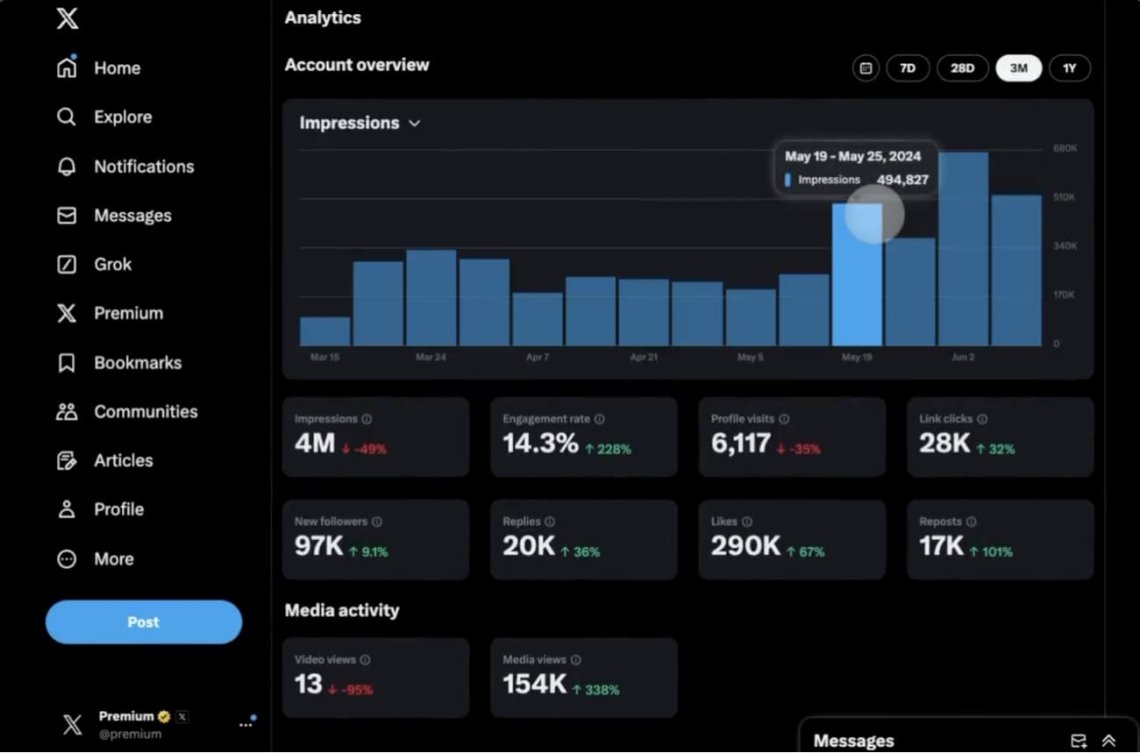
02 Presence Score
Presence Score is a metric developed by Brand24 that helps understand awareness around your company, competitors, or topics of your interest.
The presence Score metric measures the online popularity of a brand or topic at a given time. It operates on a scale from 0 to 100, where 100 is a score achieved by big, globally recognizable brands and highly popular topics. You can track the progress easily.
Here you can see the Presence Score of Nike:

How to measure?
Set up a monitoring project and go to the Analysis tab to see the Presence Score of your brand.
Check: Media Monitoring Step by Step: Setting Up a Project
Use Brand24 to measure the Presence score of your brand!
03 Website traffic
Website traffic is a metric that provides insights into how well your website performs. It can help you understand how many people are visiting your site, how they find it, and what they do once they arrive.
Study referral traffic to identify platforms that bring you visitors and analyze what type of content resonates well with your target audience. But website traffic will also indicate your owned content that performs well among your audience.
It’s worth tracking referrals and direct traffic. Those metrics will tell you:
- How many users remembered your brand name and typed your website URL directly into the search bar,
- Which digital marketing channels bring traffic.
How to measure?
Google Analytics pulls a lot of data from the website traffic. It will tell you where the referral traffic comes from. You can analyze the demographic data of your target audience. An important metric to examine is Bounce Rate, the total number of users who left your website after visiting just one page.
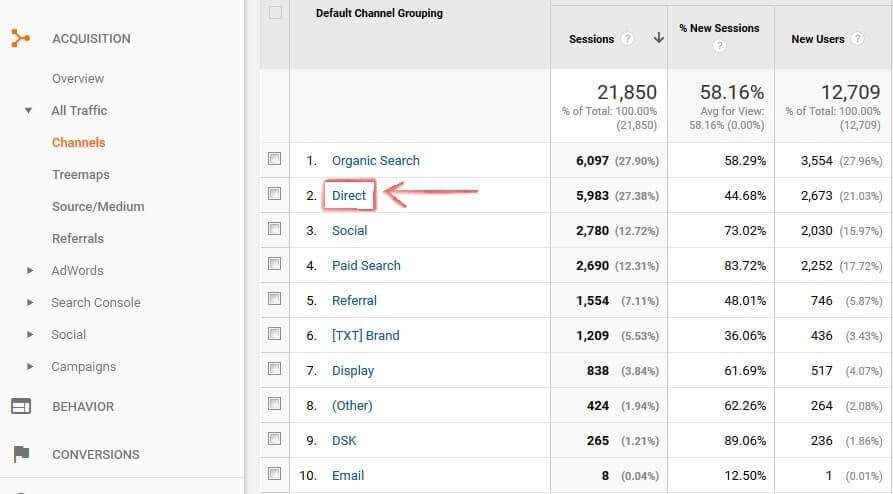
04 The volume of mentions
The volume of mentions tracks the mentions of your brand on social media and traditional online media. Many conversations about your brand happen outside your owned channels.
It’s a great way to gauge how well-known a brand is and how much buzz it’s generating.
The more media mentions a brand has, the more aware people are of it.
Knowing the volume of mentions can be helpful for a number of reasons.
First, it can show you how well your marketing efforts are working. If you see a spike in mentions after launching a new marketing campaign, it’s likely that the campaign is successful in raising brand awareness.
Second, the volume of mentions can also give you insights into what people are saying about your brand. If you see a lot of negative sentiment, it might be time to reconsider your branding strategy.
Furthermore, the tool will tell whether the online talk about your brand is positive, negative, or neutral. A high volume of mentions with prevailing positive sentiment is a sign your brand awareness campaign is yielding desired results. So it’s worth paying attention to sentiment analysis as well.
How to measure?
Using a social listening tool (such as Brand24) will ensure you’re aware of every mention. After setting up a project, you will gain access to mentions posted across social media platforms news, blogs, forums, review websites, newsletters, and podcasts.
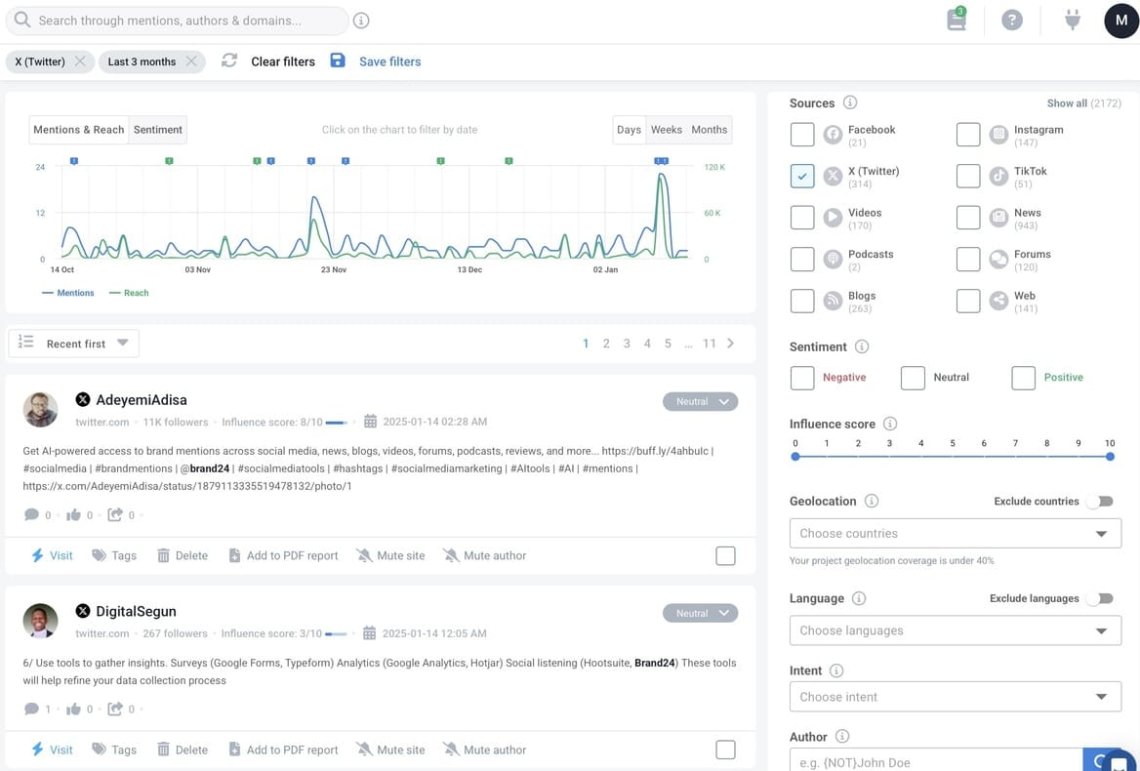
Measure the volume of mentions of your brand!
05 Brand search volume
Brand search volume is a metric that refers to the number of searches on search engines for your brand over a period of time.
You can use this metric to assess the level of interest in a brand and track changes in brand awareness over time.
Search volume data will tell you the general interest in your brand. You can then compare the results with your direct and indirect competitors to see whether there is a place for improvement.
How to measure?
You can check the organic searches for your brand using SEO tools, such as Ahrefs.
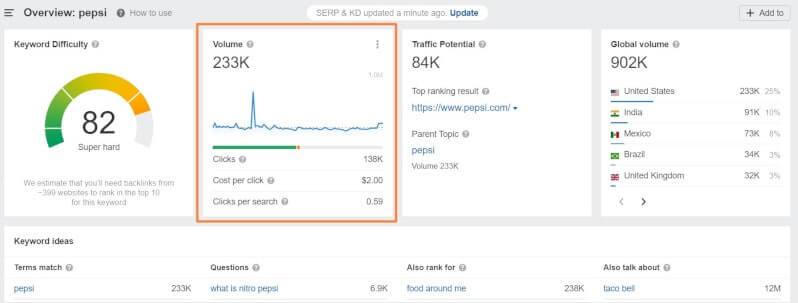
06 The share of voice
The share of voice is a metric that helps businesses understand what percentage of the conversation around a given topic is driven by their brand.
In simple terms, the share of voice is a metric telling you how much people talk about your company compared to your competitors.
You can measure SOV across various digital marketing channels, including the volume of mentions, social media, PPC, PR, and SEO.
How to measure?
We have a whole article that explains it in detail. Check: Share of Voice: Definition, Calculation, Tools
07 Social media and non-social reach
When it comes to measuring the results of a brand awareness campaign, you should also take into account the reach of your posts, generated both on social media and beyond.
Social media reach shows an estimated number of social media users that might have seen your posts.
Non-social reach calculates exactly the same, but the metric focuses on Web sources outside social media channels like blogs, newsletters, podcasts, news websites, etc.
You can measure brand awareness by monitoring the changes in reach over time. The higher the number of people that have seen your message, the higher brand awareness.
How to measure?
Social media platforms usually provide internal analytics that shows you the reach. But when it comes to measuring non-social reach, the case is more difficult.
The good news is that you can track both metrics using social listening. The tool will count social media mentions, social media reach, non-social mentions, and non-social reach.
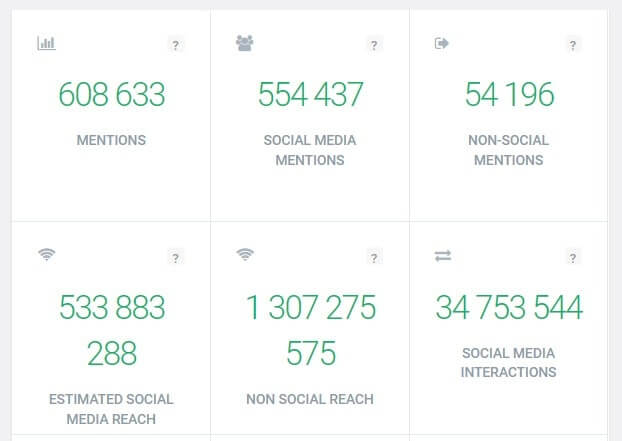
08 Social media engagement
The fact that people have seen your posts isn’t enough. To be truly successful, you need to engage with your audience.
Engagement is an indicator of the effectiveness of your social media campaign. The levels of engagement (measured in the number of likes, shares, and comments) will tell you how your content resonates with your target audience.
Brands use engagement data to gauge the success of their social media campaigns and to improve their strategies in the future.
Moreover, social media algorithms consider the engagement levels while calculating how high your content will rank on the social media wall. No doubt, high engagement levels will, ultimately, boost other brand awareness metrics.
How to measure?
Social media channels usually provide internal analytics that measures engagement. But to have all data in one place, you can use social listening tool that will show you which social media platform delivers the widest number of mentions, likes, and shares.
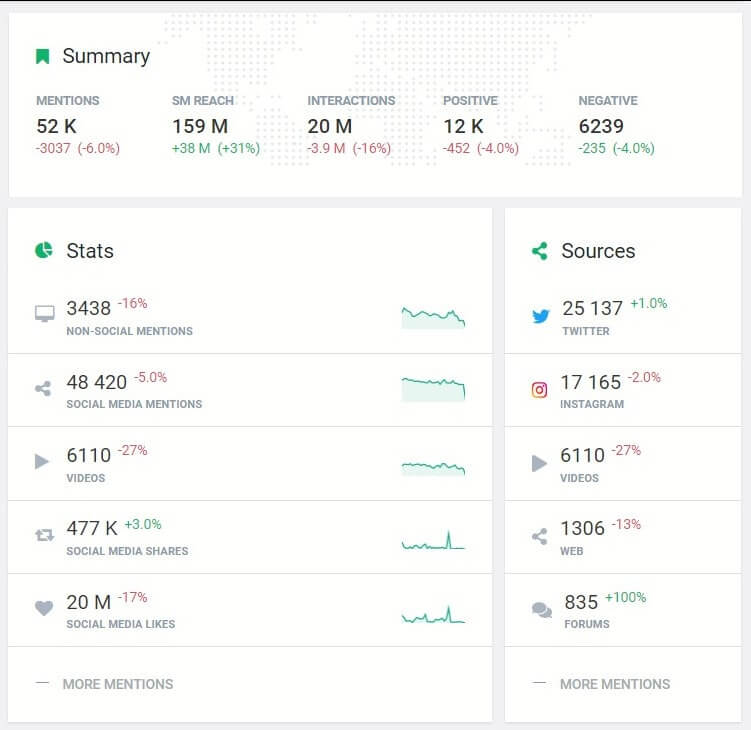
Check: Key Social Media Metrics to Track
09 Customer feedback
A brand awareness survey is a bit old-fashioned method of measuring brand awareness, yet it might prove to be very effective. You can ask your audience whether they have heard about your brand, product, or service.
Brand awareness surveys allow you to ask about aspects of your online presence that you would otherwise miss. It’s an easy way to discover customer interest, product or service knowledge, and general feelings towards the company.
Tip: Compare your brand awareness metrics to competitors
You’ve gathered a lot of insightful metrics. Now, you can assess the results of your brand awareness campaign.
The numbers you’ve gathered won’t tell you much on their own. You have to compare the results of a brand awareness campaign with other benchmarks.
Firstly, you need to establish benchmark metrics. There are two ways of doing that.
- You can monitor the metrics for some time before you start your brand awareness campaign. The metrics will serve as your baseline. You will be able to assess whether you’re making progress or not.
- The second way to establish a baseline is to take a look at your competitors.
Set up a media monitoring project and follow the same steps as in the beginning. Instead of typing in the keywords related to your business, think about your main competitor.
Analyze their brand awareness to know how you position against your main competitors.
Try Brand24 and track the most important brand awareness metrics!
Conclusion
So there you have it, key metrics that will help you track brand awareness. As you can see, we can track quite a lot of data.
I’m sure those metrics will help measure and build brand awareness.
Key takeaways:
- You need to set up brand awareness goals you want to achieve.
- Choose metrics that resonate with your goals.
- You need online tools to measure brand awareness, such as Google Analytics, Ahrefs, Brand24, or Google Adwords.
- Compare your results to competitors to learn how well your brand performs online.
- Conducting a brand awareness survey is a great way to gain insights.
Want to effectively track brand awareness metrics? Try Brand24 during a 14-day free trial
Related articles

![9 Steps to Strong Brand Awareness Strategy [2025]](https://brand24.com/blog/app/uploads/2020/12/15-The-ultimate-guide-to-brand-awareness-1400x660x2.png)
![How to Increase Brand Awareness: 15 Ways [Complete List]](https://brand24.com/blog/app/uploads/2022/10/How-to-increase-brand-awareness-.png)

![Brand Reputation: Strategy, Tips & Guide [2025]](https://brand24.com/blog/app/uploads/2024/05/brand_reputation-600x335.webp)